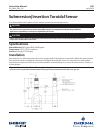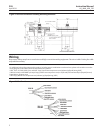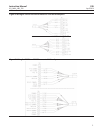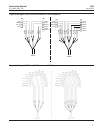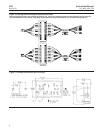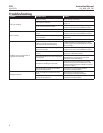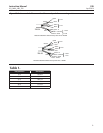
8
226 Instruction Manual
April 2014 LIQ_MAN_ABR_226
Troubleshooting
Problem Probable Cause Solution
Off-scale reading
Wiring is wrong. Verify and correct wiring.
RTD is open or shorted.
Check the RTD for open or short circuits See
Figure 13.
Sensor is not in process stream.
Conrm that the sensor is fully submerged in
the process stream. See installation section.
Sensor is damaged. Perform isolation checks. See Figure 13.
Noisy reading
Sensor is improperly installed in process
stream.
Conrm that the sensor is fully submerged in
the process stream. See installation section.
Sensor cable is run near high voltage
process stream.
Move cable away from high voltage
conductors.
Sensor cable is moving. Keep sensor cable stationary.
Reading seems wrong (lower or
higher than expected)
Bubbles are trapped in the sensor,
particularly in the toroid opening.
Install the sensor in a vertical pipe run with
the ow against the toroid opening. Increase
ow if possible.
Sensor is not completely submerged in
the process stream.
Conrm that the sensor is fully submerged in
the process stream. See installation section.
Cell constant is wrong. Wall effects are
present.
Calibrate the sensor in place in the process
piping. See calibration section.
Wrong temperature correction algorithm
is being used.
Check that the temperature correction is
appropriate for the sample. See analyzer
manual for more information.
Temperature reading is inaccurate.
Disconnect the RTD leads (Figure 13) and
measure the resistance between the in and
common leads. Resistance should be close to
the value in Table 1.
Slow temperature response to sudden
changes in temperature.
Use an RTD in a metal thermowell for
temperature compensation.
Sluggish response
Sensor is installed in a dead area in the
piping
Move sensor to a location more
representative of the process liquid.
Slow temperature response to sudden
changes in temperature.
Use an RTD in a metal thermowell for
temperature compensation.



